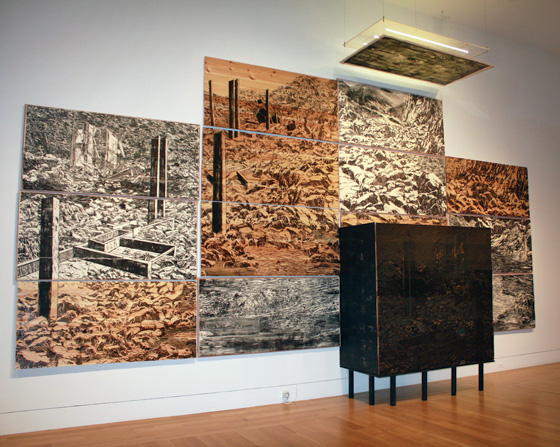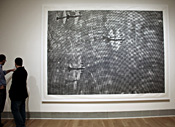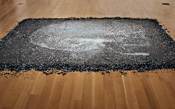
Gerard asked: Whether you like it or not, by virtue of your graduate degree, your practice is at least partially situated in printmaking. What do you gain by that and what do you lose?
On the heels of the annual Southern Graphics Conference, I feel attached to the printmaking world in a way I might not feel as intently otherwise. We are a small bunch of nerds who, if there were costumes, might gladly show up to the convention dressed up as cans of ink and rollers. That said, when I walk into the PAFA Graphic Unconscious Show, I feel a little less a part of something.
I think this feeling is part of the answer to what you gain and what you lose by situating yourself in the printmaking world. On the one hand, the printmaking world is one which addresses aptly "concepts like accessibility, democratization, dissemination, and transience" in such a way as to "inform diverse contemporary art practices while expanding the realm of printmaking itself," as the PAFA gallery guide states about the show. The thing is, I am not quite certain the show at PAFA does that very well. With some exceptions, the whole thing felt a little dry.
 When comparing the PAFA show to three of the other Graphic Unconscious Shows (Moore, Temple, and the Print Center), the PAFA one is the most traditional. Yes, the Christiane Baumgartner woodcuts are enormous and impressive in their perfect replication of photographs through handcutting means. And yes, the exhibition did feature artists from three different continents, so there is something to be said for diversity in the show. But unlike its Graphic Unconscious counterparts, most of the works were traditional wall hangings. Very few exhibited a modicum of color. And while print mastery was at its peak, innovation was not.
When comparing the PAFA show to three of the other Graphic Unconscious Shows (Moore, Temple, and the Print Center), the PAFA one is the most traditional. Yes, the Christiane Baumgartner woodcuts are enormous and impressive in their perfect replication of photographs through handcutting means. And yes, the exhibition did feature artists from three different continents, so there is something to be said for diversity in the show. But unlike its Graphic Unconscious counterparts, most of the works were traditional wall hangings. Very few exhibited a modicum of color. And while print mastery was at its peak, innovation was not. The biggest exception to this observation was the Pepon Osorio piece. Printed in an unconventional way (enormous ink jet? In pieces? We were mystified), with a more sculptural presentation, on the floor, Osorio sincerely approached the "transience" spoken about in the brochure while expanding "the realm of the printmaking" in contemporary art. The piece made us ponder not only what it meant and how we were supposed to feel, but also how the piece was fabricated and what its implications were for printmaking as it was included in the show. It was the only digital print AND that printmaking was most likely accomplished by another printer (both HP and the human component). But unlike Osorio's piece, the others were less curious.
The biggest exception to this observation was the Pepon Osorio piece. Printed in an unconventional way (enormous ink jet? In pieces? We were mystified), with a more sculptural presentation, on the floor, Osorio sincerely approached the "transience" spoken about in the brochure while expanding "the realm of the printmaking" in contemporary art. The piece made us ponder not only what it meant and how we were supposed to feel, but also how the piece was fabricated and what its implications were for printmaking as it was included in the show. It was the only digital print AND that printmaking was most likely accomplished by another printer (both HP and the human component). But unlike Osorio's piece, the others were less curious. So back to the question: I think that my foundation in printmaking is mostly a positive thing. I feel a kinship with other printmakers and I think the department does lend itself to addressing political and social issues (as is MY interest) because of the qualities and characteristics inherent to printmaking. But I am personally interested in pursuing a career as a contemporary artist. Could printmaking be a hindrance?
So back to the question: I think that my foundation in printmaking is mostly a positive thing. I feel a kinship with other printmakers and I think the department does lend itself to addressing political and social issues (as is MY interest) because of the qualities and characteristics inherent to printmaking. But I am personally interested in pursuing a career as a contemporary artist. Could printmaking be a hindrance?The answer is YES IT CAN. If printmaking is not seen as a tool, but rather an insular world, then printmakers will not be seen as artists first, but as craftsmen. I do not mean to diminish the importance of craft. I believe actually being able to MAKE things to be of the utmost importance. That said, an artist is more than just a maker. An artist is also a spokesperson. An artist is a statement maker.
Philagrafika has the opportunity to really highlight this point: printmaking is a part of the contemporary art world, not separate from it. The other shows exemplify the various ways printmaking is pushing its own boundaries. They take what we KNOW to be true of printmaking and they smash it, magnify it, tear it up, and/or re-purpose it.
But we need a reference point. And we need to fit Kiki Smith in there somewhere, right? Someone had to have the stiffer, more traditional show. It might as well have been PAFA.


No comments:
Post a Comment